Rethinking the Role and Architectural Value of the St. Andrew Kim Dae-Geon Memorial Church in the Mirinae Shrine in Korea
Abstract
:1. Introduction
1.1. Background and Purpose
1.2. Method and Procedure
2. St. Andrew Kim Dae-Geon Memorial Church and His Grave Site
2.1. From the Blessed Memorial Church to the St. Andrew Kim Dae-Geon Memorial Church
“Some priests in Hwanghae-do said to me, “Why should the Memorial Hall be built in a rural area, Mirinae? It would be better to build it in Yongsan (Senamteo), as it would be easier to worship, regarding the construction of the Memorial Hall at the old grave site of the martyr Father Kim Dae-Geon”. I said to them, “I [Kang Do-Young] do not intend to build it in Mirinae and do not force to donate promised money to pay last year. The money donated by some priests was left to the bookkeeper, and whether it should be located in Mirinae or Yongsan depends on the will of bishop.””(Kang 2016, pp. 210–11; emphasis added)12
“Rather than Senamteo, where [Father Kim Dae-Geon] was killed, we should build the Oratorium in Mirinae, where he has been buried for 55 years (1846–1901)… Bishop Go’s grave is here as well and the Oratorium should be built in Mirinae to commemorate the passion of the Mirinae Shrine people who brought the body of Father Kim Dae-Geon there.”(Oh 1961, p. 47; Cha 2008, p. 210; emphasis added)
“Since Catholicism was introduced in Korea, there were many martyrs due to the brutal killing of believers. To honor them, a beatification ceremony was held for 79 martyrs, whose pilgrimage achievements and values can be attested to, to award them the title of the Blessed. This is not only an honor for the Korean Catholic Church but also a model expression of the Korean People’s brave spirit and faith. … Among the blessed martyrs, the person with the most special achievements is Father Kim Dae-Geon. The church built around his grave was called the Blessed Memorial Church and so it became a permanent holy worship hall for Korean Catholic believers.”(The Dong-A Ilbo 1928, p. 4; emphasis added)
2.2. Father Kim Dae-Geon’s Grave and Surrounding Other Graves
3. Architectural Features and Preservation of the Memorial Church
3.1. Architectural Features of the Memorial Church
“I came to Mirinae 15 days ago, and I plan to stay here until this weekend. I saw Chinese were building the Blessed St. Andrew Kim Dae-Geon Memorial Oratorium. The oratorium was completed last Saturday. Now they are building walls around the oratorium. The oratorium and altar stone were made with concrete. The grave for the Martyrs will be made with concrete like the grave of Bishop Jean Joseph Ferréol who ordinated the Blessed St. Andrew Kim Dae-Geon (9 July 1928).”(Kang 2016, pp. 570–71; emphasis added)16
3.2. Change Process and Preservation of the Memorial Church and the Surrounding Site
3.2.1. Changes to the Surrounding Site of the Memorial Church
3.2.2. Evaluation of Value of Preserving the Memorial Church
4. Sense of Place (or Genius Loci) of the Memorial Church and the Surrounding Grave Site
“We should therefore have to say how we inhabit our vital space, in accord with all the dialectics of life, how we take root, day after day, in a “corner of the world.”
5. Conclusions
Funding
Acknowledgments
Conflicts of Interest
| 1 | Gongso (公所, Small Catholic Church) is a Catholic place of worship smaller than a parish church. It is a gathering of local believers where the provost does not reside. As a priest does not reside there, mass is not held; instead, a service is held in which offertory is omitted, centered on the head of the Catholic church who acts for the parish church priest. |
| 2 | Mirinae means “The milky way is flowing under the moonlight” in Korean, and it was called Mirinae because the light under the moonlight looks similar to the Milky Way. During the Catholic Persecution of 1801 (Shinyu) and 1839 (Gihae), Catholic believers came and hid there. They were scattered widely, living by carving vessels and clearing fields. |
| 3 | Beatification is the Pope’s declaration allowing the title of the Blessed for a reputed person due to martyrdom. |
| 4 | On 2 November 2020, the name of “Memorial Oratory for 79 Blessed Korean Martyrs” within Mirinae Shrine in Anseong was changed to the “St. Andrew Kim Dae-Geon Memorial Church” in the Suwon Catholic parish. |
| 5 | The rest of the remains were buried in Daeshin Seminary in Hyehwa-dong and then were relocated to the Jeoldusan Martyrs’ Memorial Hall. |
| 6 | There are pastoral letters including “Bishop Mütel’s Diary”, letters of Bishop Mütel during his priest period and a collection of letters of Father Mark Kang Do-Young. |
| 7 | Name or title are exalted in the world. |
| 8 | “Oratory”, Merriam-Webster, https://www.merriam-webster.com/dictionary/oratory, accessed 3 April 2021. |
| 9 | In general, the oratorium of bishops is regarded as oratorium semi-publicum. |
| 10 | Article 1188.2 of the Church Code in 1917. |
| 11 | Original text: see 5–9 May 1921 and 15–22 May 1922of Bishop Mütel’s diary for the date of Korean priests’ retreat date during 1921 and 1922. |
| 12 | Original text: Mütel Document 1922–1975, Father Kang Do-Young’s letter dated 30 May 1922. The underlines in the quotation in the statement were made by the author of this paper to emphasize. |
| 13 | The author arranged the details by adding some more, centered on Chapter 3, the St. Adrew Kim Dae-Geon and Mirinai Memorial Oratorium History—“Memorial Church Mirinai Shrine, Father Kim Dae-Geon’s Grave, and Mirinai Church”, drawn up by Cha Gi-Jin in the Cultural Asset Registration Application Form drawn up in 2009. |
| 14 | Originally quoted in Tabella Supplementum Tabella SS. Cordis Jesu n. 34 (20 October 1928). |
| 15 | http://encykorea.aks.ac.kr/Contents/Item/E0076853, accessed on 10 May 2021. |
| 16 | Originally quoted in Tabella Supplementum Tabella SS. Cordis Jesu n. 34 (20 October 1928). |
| 17 | Although the Memorial Church is broadly classified as Gothic style according to existing research, in my opinion, the church should be seen as the mixture of Gothic and Romanesque styles. |
| 18 | For the initial research on the Jeondong Catholic Church, please see the following research: Jung-Shin Kim, “Jeondong Catholic Church”, Monthly Architecture and Culture n. 40 (September 1984): 24–28. |
| 19 | Based on “The Criteria for Selection” with the UNESCO World Heritage, http://whc.unesco.org/en/criteria/, accessed 2 April 2021. |
| 20 | See above the Criteria for Selection with the UNESCO World Heritage. |
| 21 | The factors determining authenticity are the following six and each factor consists of a pair of two items: form and design, material and substance, location and setting, use and function, tradition and technique, and spirt and feeling. |
| 22 | See above for the criteria for selection with the UNESCO World Heritage. |
References
- Bachelard, Gaston. 1994. The Poetics of Space. Translated by Maria Jolas, with a new foreword by John R. Stilgoe. Boston: Beacon Press. [Google Scholar]
- Baek, Chang-Hyun. 2020. The Name of Memorial Cathedral for Beatification in Mirinae, Anseong will be Changed to the St. Andrew Kim Dae-Geon Memorial Church. Joongbu Ilbo. (3 November 2020). Available online: http://prt.joongboo.com/news/articleView.html?idxno=363453787 (accessed on 28 March 2020).
- Carmona, Matthew, Tim Heath, Taner Oc, and Steven Tiesdel. 2010. Public Places—Urban Spaces. London: Taylor & Francis Group. [Google Scholar]
- Catholic Bishops’ Conference of Korea. 1927. Construction of Monument in the Relocated Grave of the Blessed St. Andrew Kim Dae-Geon. Gyeonghyang Magazine, May 15. [Google Scholar]
- Catholic Suwon Parish Maintenance Foundation. 2009. Cultural Asset Registration Application Form. Suwon: Catholic Suwon Parish Maintenance Foundation. [Google Scholar]
- Cha, Gi-Jin. 2008. Father Mark Kang, Do-yeong (1863–1929) and his Celebrating Movement for St. Andrew Kim, Dae-geon. Research Journal of Catholic Church History 5: 209–34. [Google Scholar]
- Dallet, Claude-Charles. 1980. The History of Korean Catholic Church (Histoire de l’Eglise de Corée) Part 2. Translated by Eung-Ryul Ahn, and Seok-Woo Choi. Seoul: The Research Foundation of Korean Church History. [Google Scholar]
- Kang, Do-Young. 2016. Father Mark Kang Do-Young’s Collection of Letters. Edited by Seung-Ryong Choi. Seoul: The Research Foundation of Korean Church History. [Google Scholar]
- Guinand, Antoine Louis. 1928. Tabella Supplementum Tabella SS. Cordis Jesu, 34, (20 October 1928).
- Catholic Parish of Suwon- Great Success of the Pilgrimage. Gyeonghyang Magazine 1160: 555, (1 November 1964).
- Heidegger, Martin. 1977. The Question Concerning Technology. In Basic Writings. New York: Harper & Row, pp. 307–41. [Google Scholar]
- ICOMOS. 1964. The Venice Charter: International Charter for the Conservation and Restoration of Monuments and Sites. Paris: ICOMOS. [Google Scholar]
- Im, Seok-Ja. 2011. The History of Western Architecture. Seoul: Bookhouse. [Google Scholar]
- Jung, Ja-Yeon. 2020. St. Andrew Kim Dae-Geon Memorial Church in Mirinae Shrine of Anseong Regained its Original Name. Kyeonggi Ilbo. November 3. Available online: https://www.kyeonggi.com/news/articleView.html?idxno=2326314 (accessed on 2 April 2021).
- Jung, Jong-Deuk. 2008. The Historical Significance of Mirinae Shrine. Research Journal of Catholic Church History 5: 7–46. [Google Scholar]
- Kim, Jung-Shin. 1984. Jeondong Catholic Church. Monthly Architecture and Culture 40: 24–28. [Google Scholar]
- Lee, Seok-Won. 2008. The Change and Historical Meaning of Mirinae Parish; Especially in the Changing Aspects of his Religious Influence and of Catholic Communities Kong-so. Research Journal of Catholic Church History 5: 235–82. [Google Scholar]
- Lee, Seung-Hoon. 2020. Change of the Name from Memorial Oratory for 79 Blessed Korean Martyrs. Catholic Times. November 8. Available online: https://m.catholictimes.org/mobile/article_view.php?aid=349079¶ms=page%3D1%26acid%3D1%26top%3D1 (accessed on 1 April 2021).
- Lee, Su-Jung. 2017. Conservation Ethics. Seoul: Graphickorea. [Google Scholar]
- Lee, Su-Jung. 2018. Conservation Philosophy. Review of Architecture and Building Science 57: 14–18. [Google Scholar]
- Lukermann, Fred E. 1964. Geography as a Formal Intellectual Discipline and the Way in which it Contributes to Human Knowledge. Canadian Geographer 8: 167–72. [Google Scholar] [CrossRef]
- Nora, Pierre. 1989. Between Memory and History: Les Lieux de Mémoire. Representations 26: 7–24. [Google Scholar] [CrossRef]
- Oh, Seok-Geun. 1961. The Life and Achievements of Korea’s Third Father Kang Mal-Gu (Do-Young). Catholic Youth 15: 40–50. [Google Scholar]
- Relph, Edward. 1976. Place and Placelessness. London: Pion. [Google Scholar]
- Seo, Myengsoo. 2014. Cultural sustainability through architectural preservation: A case study of Frank Lloyd Wright’s Florida Southern College. International Journal of Sustainable Building Technology and Urban Development 5: 135–42. [Google Scholar] [CrossRef]
- Stovel, Herb. 2007. Effective Use of Authenticity and Integrity as World Heritage Qualifying Conditions. City & Time 2: 21–36. [Google Scholar]
- Suwon Research Institute of Catholic History. 2017. 50 Years of History of Suwon Parish: 1963–2013 I. History of Parish. Suwon: Catholic Parish of Suwon. [Google Scholar]
- The Dong-A Ilbo. 1928. St. Andrew Kim Dae-Geon Memorial Church. The Dong-A Ilbo, October 5. [Google Scholar]
- Uhr, Jeong-Yeun, and Hong-Koo Yuh. 2010. A Study on Place Value on the Notion Place. Korea Planning Association 4: 21–34. [Google Scholar]
- UNESCO. The Criteria for Selection. Available online: http://whc.unesco.org/en/criteria/ (accessed on 2 April 2021).

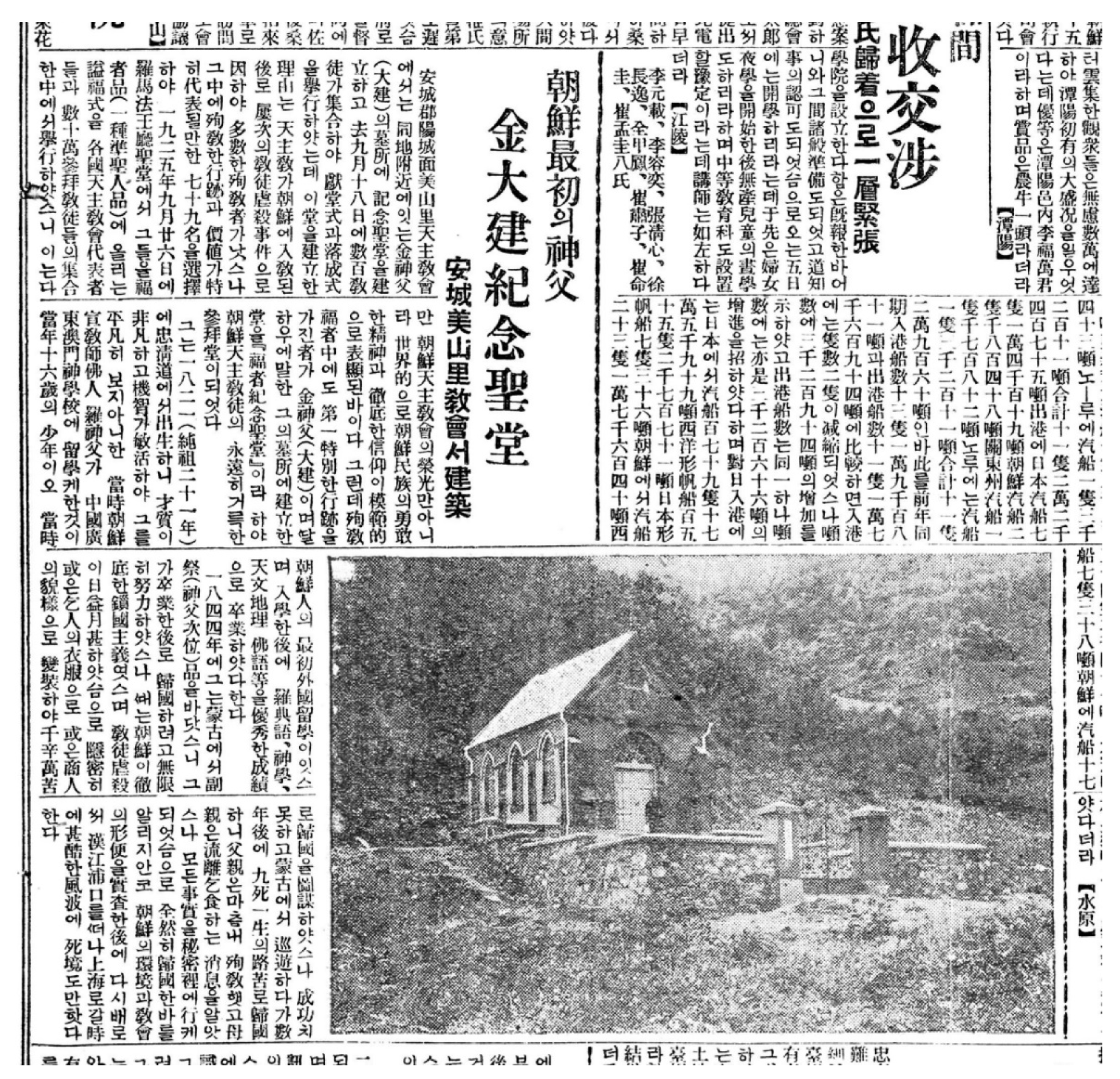
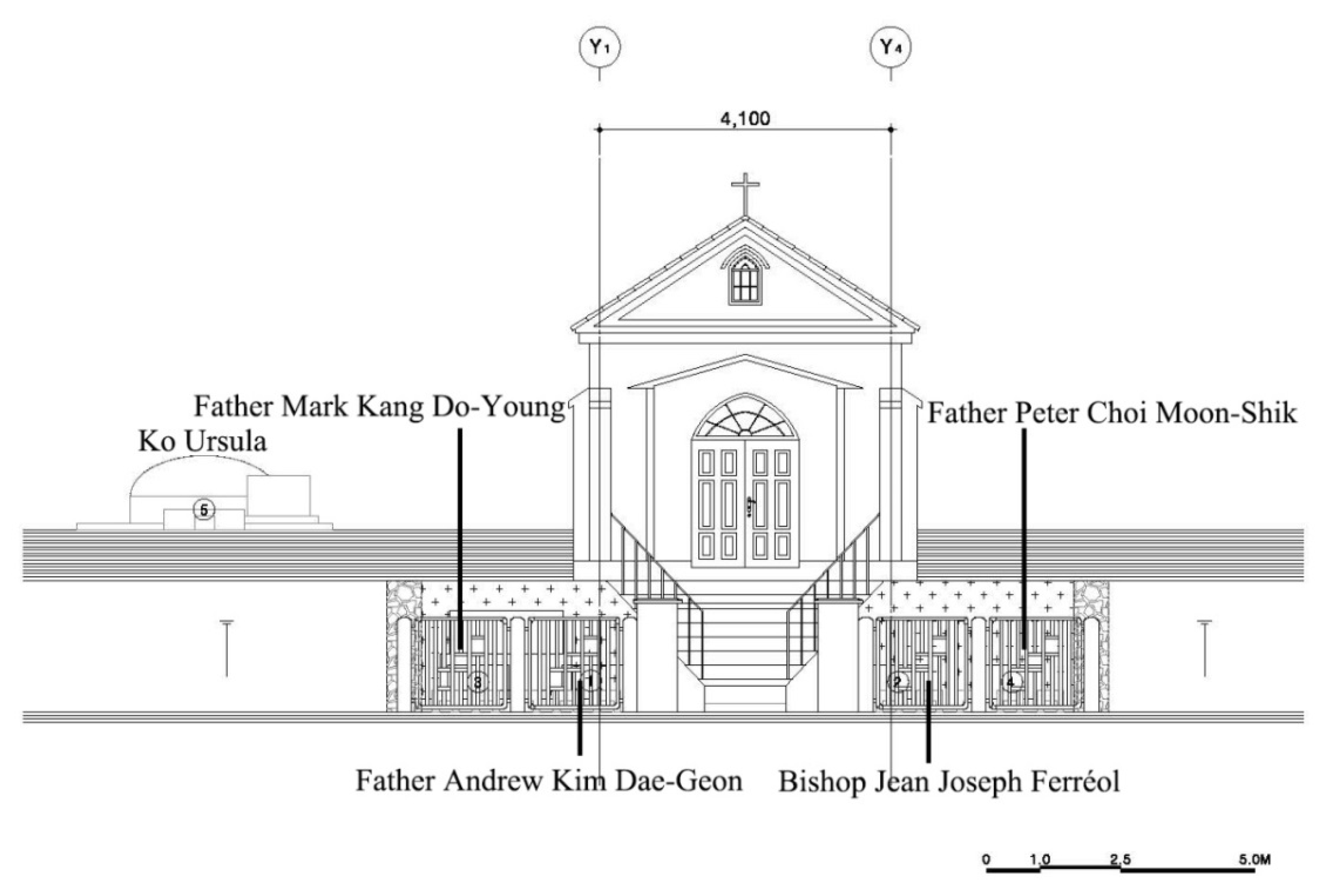
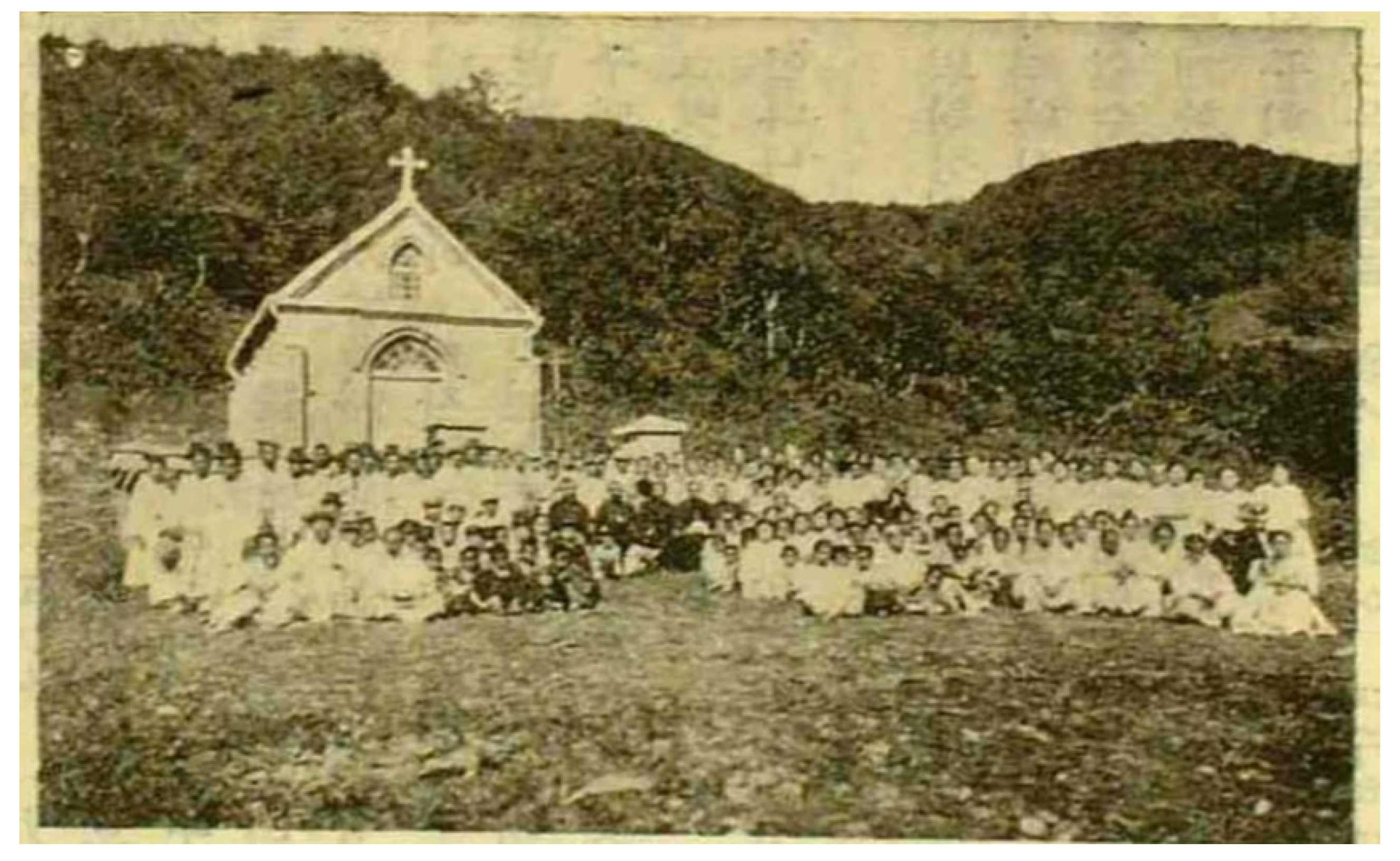



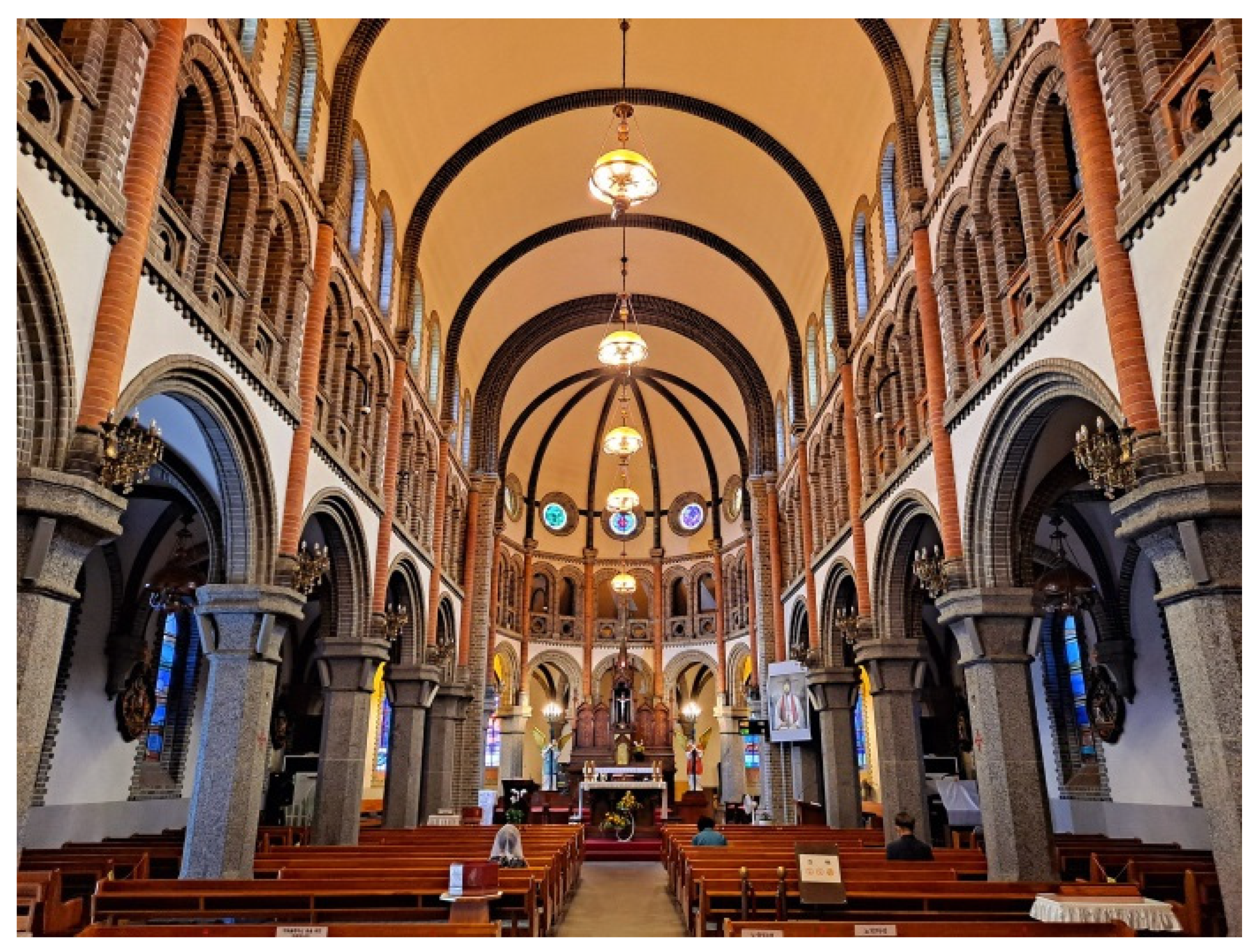

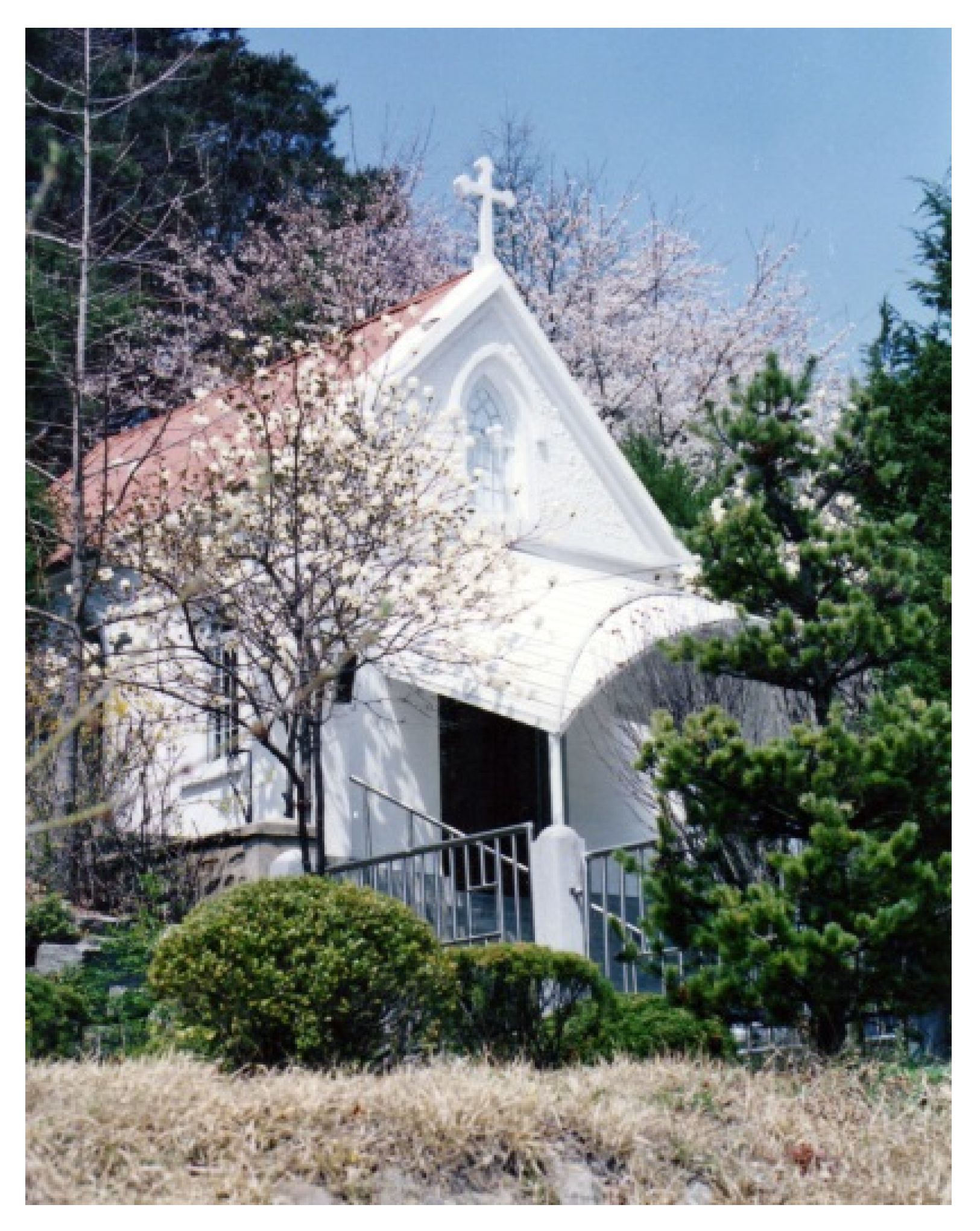

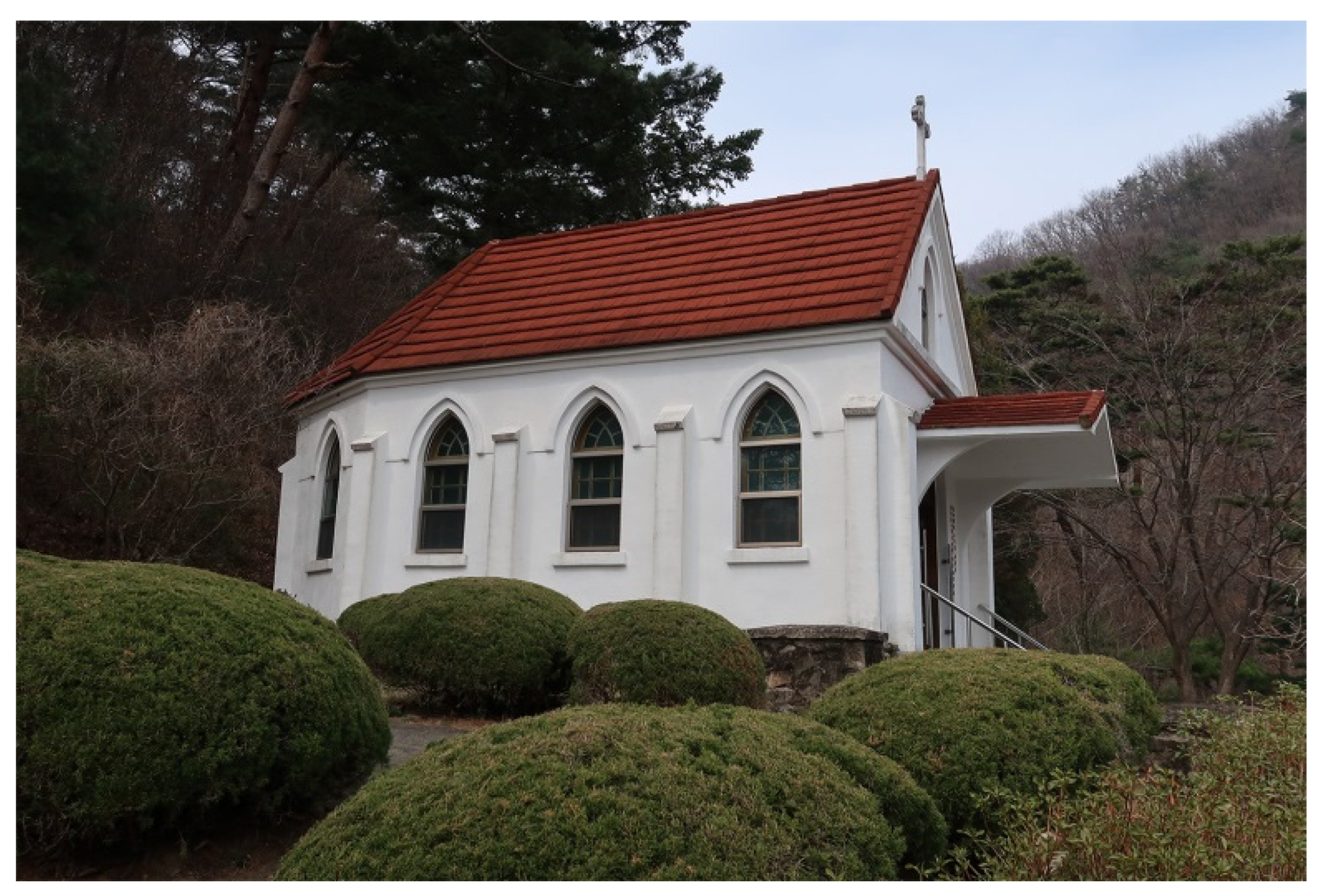
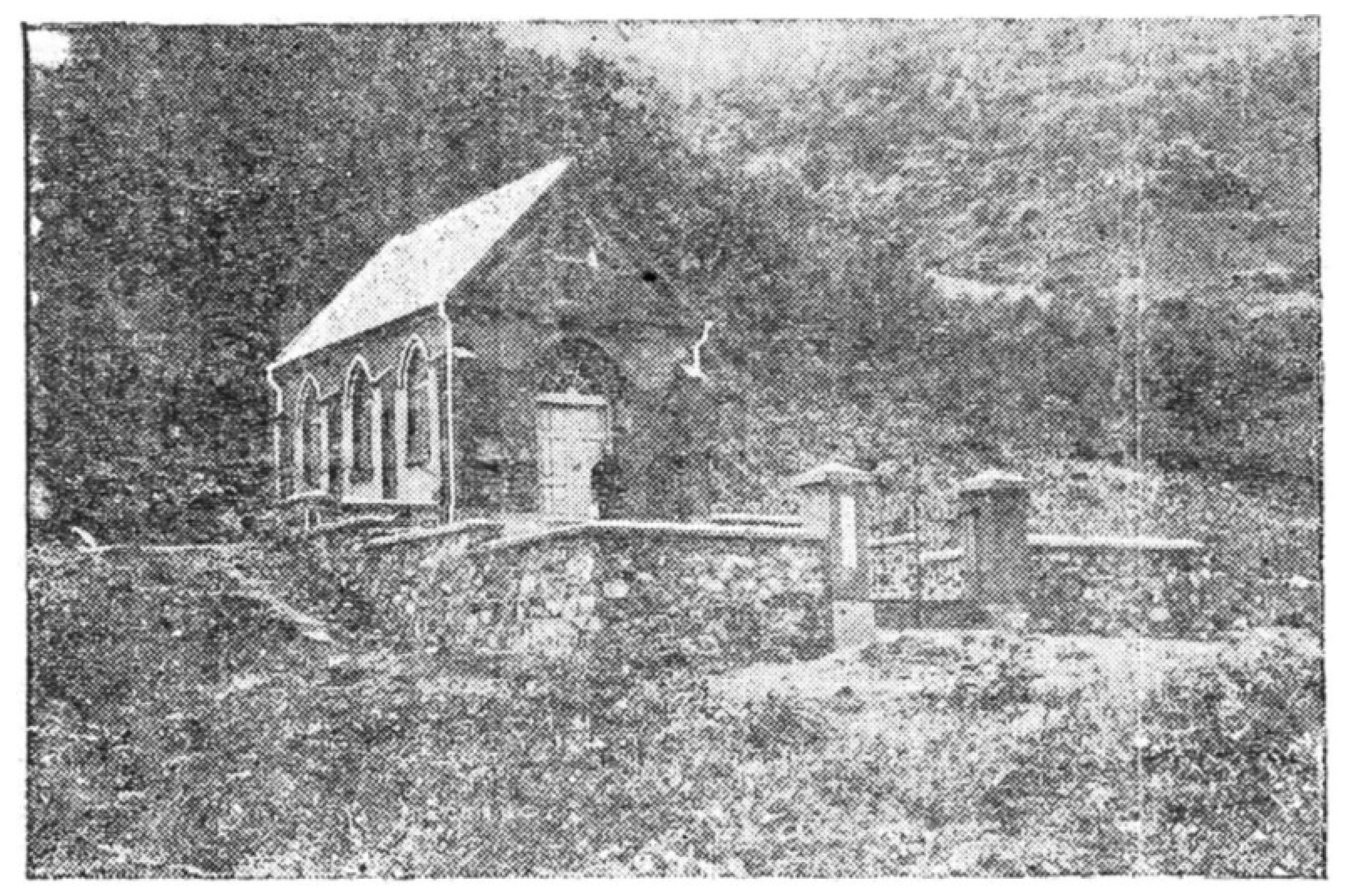


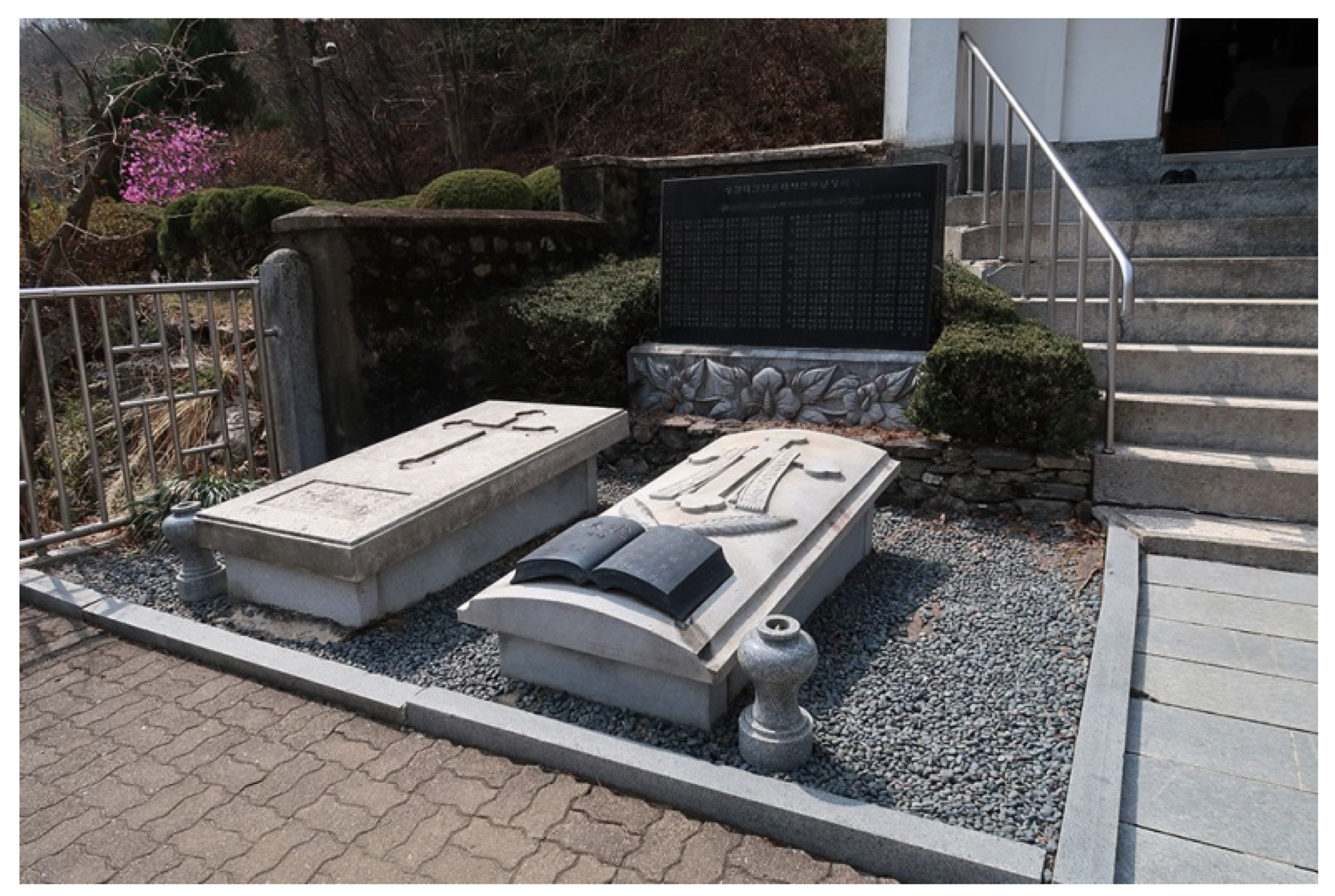
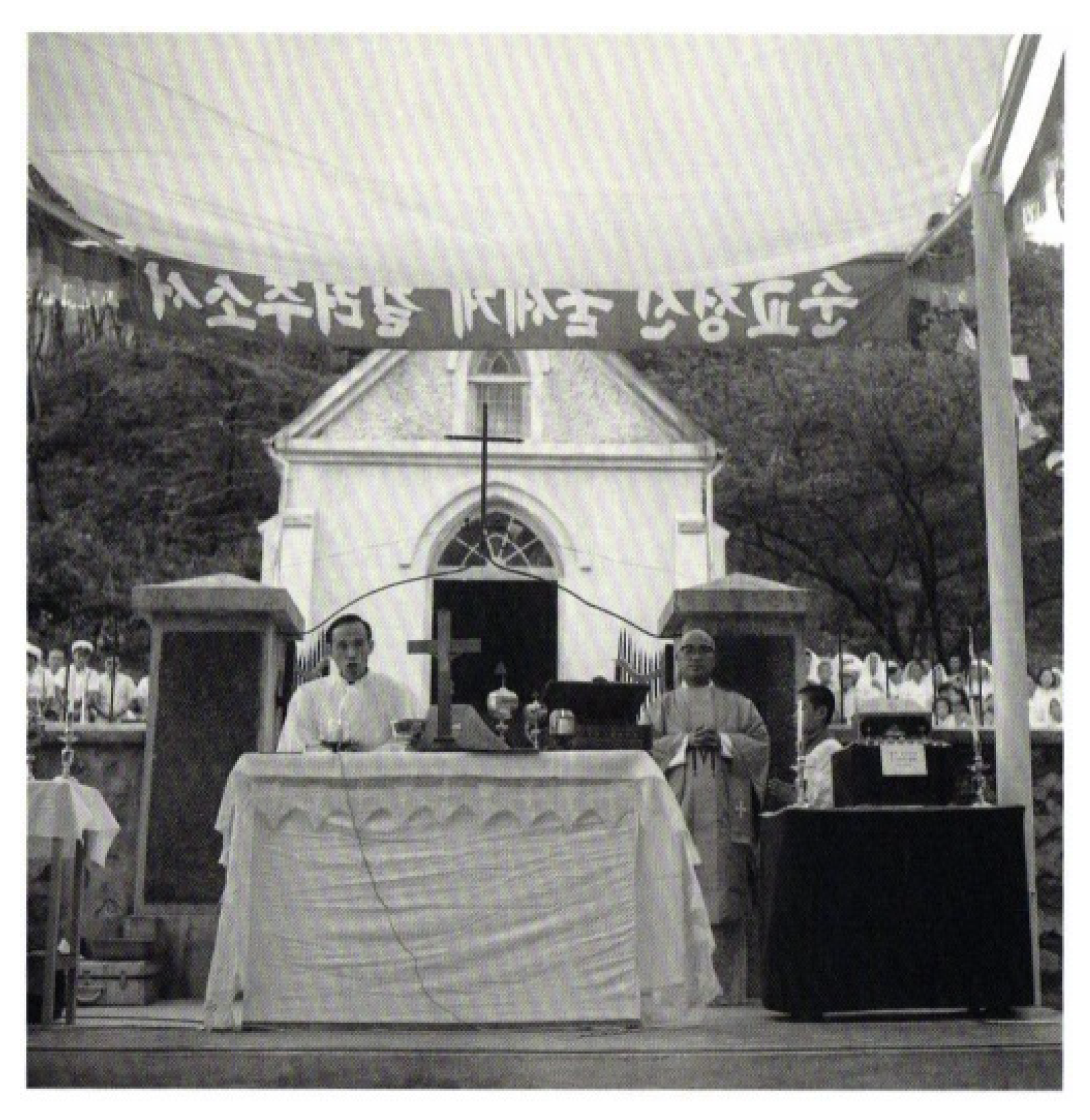
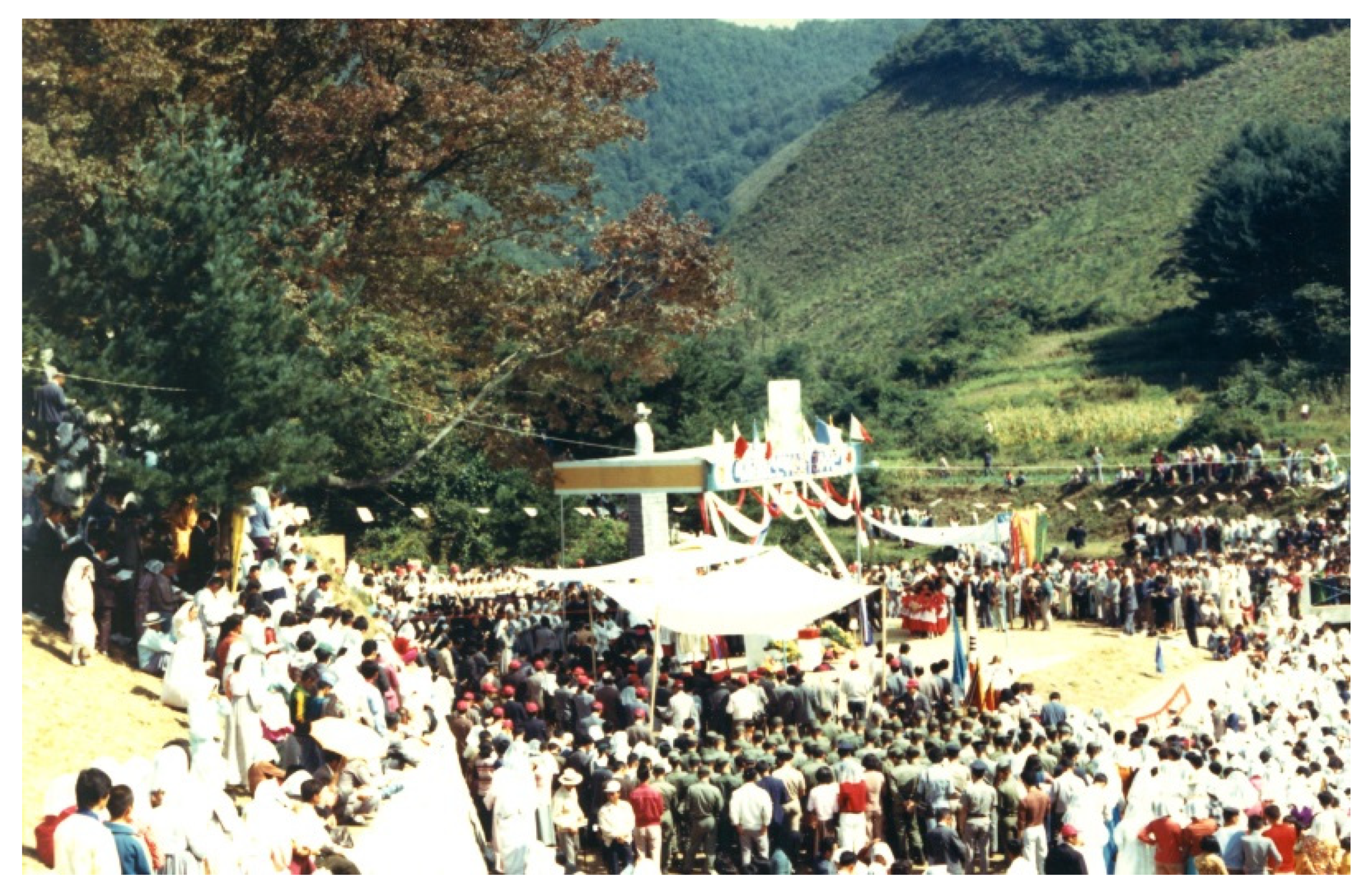
| Date | Details |
|---|---|
| 5–8 May 1921 | Decision to build a Memorial Hall to exalt Father Kim Dae-Geon during the Korean priests’ retreat. |
| 15 May 1922 | As the issue of building St. Andrew Kim Dae-Geon Memorial Hall was discussed once more during the Korean priests’ retreat, opinions on where to build it were exchanged. |
| July 1928 | The Blessed St. Andrew Kim Dae-Geon Memorial Oratorium is completed. |
| 18 September 1928 | The above Memorial Oratorium is dedicated as the “Korean martyrs’ Our Lady of Angels Memorial Oratorium” with Bishop Larribeau officiating. The Memorial Oratorium becomes the Korean Catholic Church’s representative martyrs’ exaltation pilgrimage memorial oratorium. |
| 12 March 1929 | Father Kang Do-Young dies, and his body is buried near Father Kim Dae-Geon |
| 11 October 1952 | The third provost of Mirinae Church Father Peter Choi Moon-Shik dies and his body is buried near Father Kim Dae-Geon. |
| 5 July 1960 | The bones of the extremities (toe bones) and coffin pieces of the Blessed Father Kim Dae-Geon are buried in the Memorial Oratorium. The other remains are buried in Daeshin Seminary in Hyehwa-dong, and later transferred and buried in the Martyrs Memorial Hall of Jeoldusan. |
| 26 September 1965 | The remains of Ko Ursula and Lee Min-Shik are transferred from below the Memorial Oratorium to their present site outside and a plaza is constructed there. |
| 26 September 1976 | Foreign bishops visit Korea to participate in the Far Eastern Bishops’ the Blessed Exaltation Convention held to mark the 130th anniversary of Father Kim Dae-Geon’s martyrdom. Korean bishops jointly officiate the exaltation mass. On the same day, the unveiling ceremony of the marble statue of Father Kim Dae-Geon is held. |
| 6 May 1984 | Canonization of the 103 martyrs, the Blessed including the Blessed Father Kim Dae-Geon—celebrant: Pope John Paul II. |
| 2009 | The Catholic Suwon Parish Maintenance Foundation presents a Cultural Asset Registration Application Form for cultural heritage conservation according to state-designated cultural asset registration of Father Kim Dae-Geon’s grave, St. Andrew Kim Dae-Geon Memorial Church, and St. Joseph’s Church. |
| 2013 | The Mirinae Shrine Development Committee applies for the Registered Cultural Properties of the Memorial Oratory for 79 Blessed Korean Martyrs and the area surrounding Father Kim Dae-Geun’s grave. |
| 2 November 2020 | The Catholic Suwon Parish changes the name of the 79 Korean Martyrs Beatification Memorial Oratorium to St. Andrew Kim Dae-Geon Memorial Church. |
Publisher’s Note: MDPI stays neutral with regard to jurisdictional claims in published maps and institutional affiliations. |
© 2021 by the author. Licensee MDPI, Basel, Switzerland. This article is an open access article distributed under the terms and conditions of the Creative Commons Attribution (CC BY) license (https://creativecommons.org/licenses/by/4.0/).
Share and Cite
Seo, M. Rethinking the Role and Architectural Value of the St. Andrew Kim Dae-Geon Memorial Church in the Mirinae Shrine in Korea. Religions 2021, 12, 919. https://doi.org/10.3390/rel12110919
Seo M. Rethinking the Role and Architectural Value of the St. Andrew Kim Dae-Geon Memorial Church in the Mirinae Shrine in Korea. Religions. 2021; 12(11):919. https://doi.org/10.3390/rel12110919
Chicago/Turabian StyleSeo, Myengsoo. 2021. "Rethinking the Role and Architectural Value of the St. Andrew Kim Dae-Geon Memorial Church in the Mirinae Shrine in Korea" Religions 12, no. 11: 919. https://doi.org/10.3390/rel12110919





